Automation V3: Gearset DevOps CI/CD via Jenkins
This page describes a solution for setting up integration from Gearset DevOps to execute a Jenkins CI Server Job to execute a suite of Provar tests. Optionally you can write the test results back to a custom object in Salesforce. We’ve listed a free AppExchange package that can be used for that purpose, or you can integrate your test results into an RDBMS connection or via other web services. The process is broadly the same for any other DevOps CI/CD tool that doesn’t run ANT natively but does allow you to configure Webhook or HTTP Callouts.
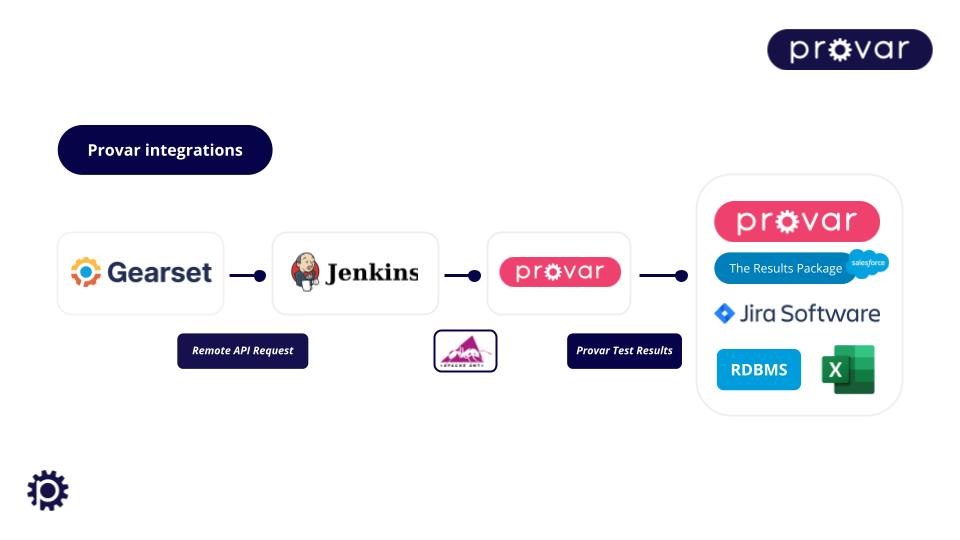
AWS Configuration
If you’re using a locally hosted Jenkins instance, please ensure it is within your corporate DMZ and can accept incoming connections from Salesforce. If this is the case, you can skip to the next section. The range of Salesforce IP addresses is long and ever-changing, so we recommend a cloud-hosted instance unless you need to execute end-to-end tests with internal systems.
An AWS instance should be configured following the AWS Set Up a Jenkins Server guide. Note the full public AWS DNS JENKINS_URL must be used, not just the IP address,
e.g., http://ec2-user@ec2-34-245-70-169.eu-west-1.compute.amazonaws.com:8080.
After completing your setup, ensure you can access your new Jenkins Admin screen remotely using the JENKINS_URL from your local desktop browser before continuing and not just on the AWS instance using localhost:8080 or localhost:8443. If this fails, you must check your AWS Configure Security Group and ensure it’s been applied to your AWS instance. Do not proceed until this is working.
If installing onto a Windows Server, you must create an Inbound Port Forwarding rule on Windows Firewall for port 8080 or 8443. Do not restrict source IP access unless you plan to whitelist every Salesforce IP address.
You are responsible for locking down this AWS instance and Jenkins to meet your corporate security standards. The instance must be accessible from the Gearset DevOps tool.
Jenkins Configuration
Follow the Provar Setting Up Continuous Integration guide.
After configuring the server, the CSRF Protection needs to be disabled in the Manage Jenkins -> Configure Global Security. The default settings for the Access Control should be left below until your integration is working, and then it can be locked down using Matrix-Based Security.
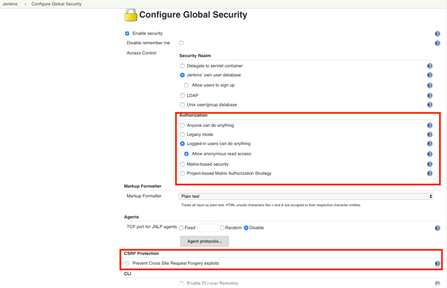
Note: By enabling Read Only Anonymous access, you can allow non-authenticated users to inspect the results of the build action. Disable this if you do not want to let this be publicly visible to anyone with the Jenkins server URL, and set up any other non-admin user access you require instead.
We recommend not using your Jenkins Admin user credentials for triggering remote builds and creating a new user specifically for this purpose, using Manage Jenkins -> Manage Users to add a new user.
For the Jenkins user you want to use to trigger tests remotely, note the Username and API Token to be used. The password is not required for API access and should never be shared externally.
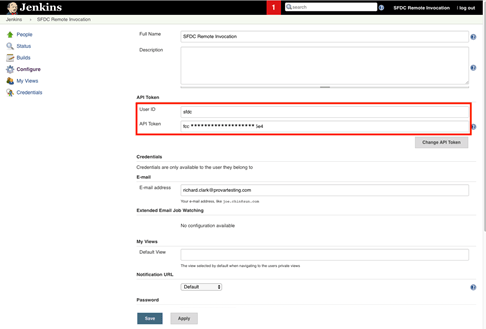
Note: You need to log in as the user to be used and click the Show API token BEFORE restricting access if using the Matrix-based security.
Although you can integrate with the Jenkins Admin user, we strongly recommend that you create a new user identity in the Manage Jenkins -> Manage Users and limit their execution to execute build jobs only once you have your integration working and have captured the API Token as above for the new user:
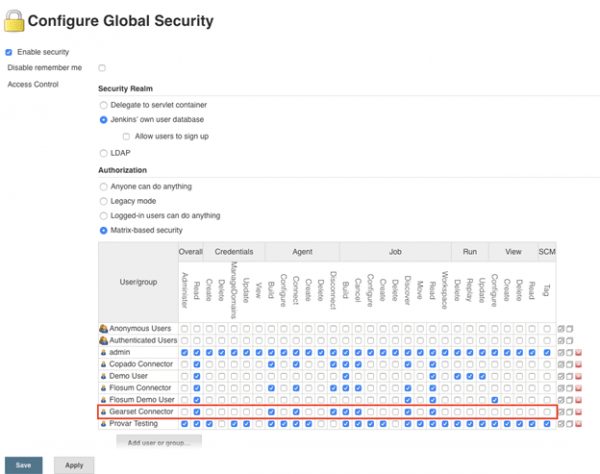
Deploy your test cases to your Jenkins CI Server, or integrate with your Version Control repository within the Build job you wish to trigger.
Jenkins Remote API Configuration
Depending on your AWS Instance, you must follow the standard install for either Windows or Linus to set up and license Provar for your execution environment.
You should also read carefully and follow all appropriate steps in the Provar DevOps guide.
When configuring your Provar Build Job, ensure the job is made available as a Remote Build and make a note of your Build Authentication Token and the Build URL. For remote invocation, we recommend creating an additional user for this purpose. See section. For simplicity, we recommend using the buildWithParameters version of the Build URL to allow you to pass options for which Provar ANT target and tests to be executed.
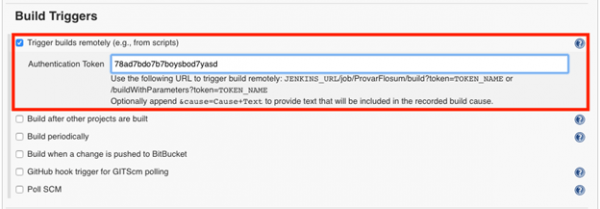
You can also add the following optional parameters if you wish to override the Test Case Path and/or the ANT target to be executed. You must ensure you account for these in your corresponding Provar build.xml file.
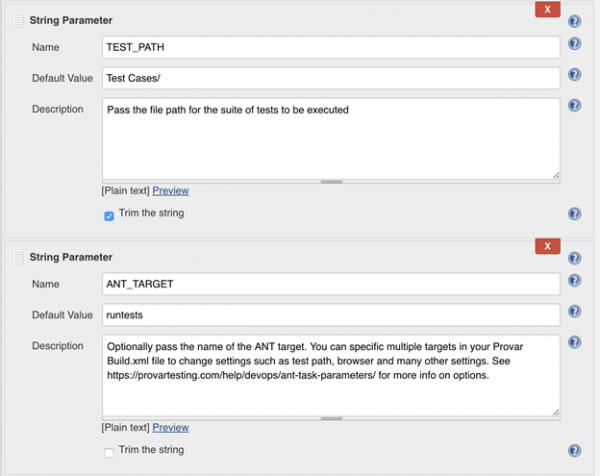
You can name these parameters whatever you wish and ensure you apply them consistently across Jenkins, the build.xml, and your webhook callout from Gearset DevOps.
Provar build.xml
If you are using the optional parameters in Process Builder to pass the Test Case Path and/or ANT target, make the following additional changes to your build.xml:
- For Test Path, replace

with

- For creating alternate ANT targets, copy the entire … block and paste underneath, updating the target name to be unique and changing the test execution parameters as desired.

Gearset DevOps Configuration
Within Gearset, there is an option to configure outgoing webhooks as part of a CI Job. For complete documentation, see the Gearset website: https://gearset.com/blog/outgoing-webhooks-for-ci
For the CI Job you wish to trigger a Provar test run, click on the link to Edit Job and then navigate to the Outgoing webhooks tab:
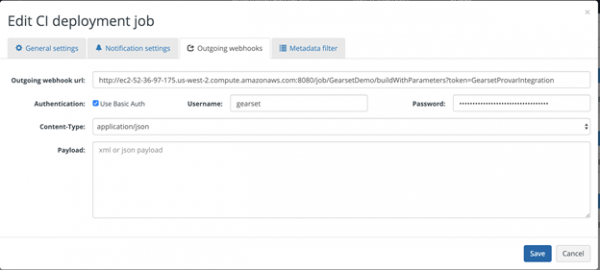
Complete the following:
- Outgoing webhook URL: This is the Build URL from your Jenkins configuration
- Authentication: Check the Use Basic Auth and provide the Jenkins Username and API Token for the Gearset user (if you created one as advised)
Content Type and Payload are not required if you have used the buildWithParameters Jenkins URL.
NOTE! If you are passing parameters to the Jenkins Provar job, then you will need to include them in your Build URL, for example:
http://ec2-52-36-97-175.us-west-2.compute.amazonaws.com:8080/job/GearsetDemo/buildWithParameters?token=GearsetProvarIntegration&TEST_PATH=Test%20Cases/Success&ANT_TARGET=runtests
We recommend testing your integration without the additional parameters and then adding them once Gearset triggers your Jenkins job.
Testing Checklist
We recommend you test each part of the process before running end to end. Ensure each of the following works to diagnose any issues you have:
- The server where Jenkins is deployed can be reached remotely, or at least the Jenkins instance accessed. If this fails, your AWS Security Rules or Server Firewall may block connections. Ensure the Jenkins port (e.g., 8080) is permitted for Inbound Connections and re-test.
- The Provar job on the Jenkins server can be executed within the Jenkins admin console. If this fails to examine the errors, fix the root causes and re-test.
- The Provar job on the Jenkins server can be executed remotely from the command line using curl. If this fails to examine, the error is returned. The most likely cause is Jenkins Global Security. Try opening up access and re-testing to diagnose the issue.
- A Gearset DevOps CI Job triggers a new Jenkins build for the Provar job.
- Add the optional parameters to pass which test cases you wish to execute and/or which ANT target to invoke.
Hopefully, you have a fully working end-to-end process to execute your Gearset-based Continuous Delivery Cycle; well done!
- Home
- Get Started with V3
- AI with Provar Automation V3
- Automation V3: Understanding Provar’s Use of AI Service for Test Automation
- Automation V3: Provar Assistant
- Automation V3: Image Validator
- Automation V3: Intent Validator
- Automation V3: Test Data Generation
- Automation V3: Test Step Generation
- Automation V3: Utterance Generator
- Automation V3: Using Standardized Test Agent APIs
- Using Provar Automation V3
- Automation V3: Content Synchronization
- Automation V3: Feature-by-Feature Guide
- Automation V3: Provar Automation
- Automation V3: Creating a New Test Project
- Automation V3: Import Test Project from a File
- Automation V3: Import Test Project from a Remote Repository
- Automation V3: Import Test Project from Local Repository
- Automation V3: Commit a Local Test Project to Source Control
- Automation V3: Salesforce API Testing
- Automation V3: Behavior-Driven Development
- Automation V3: Consolidating Multiple Test Execution Reports
- Automation V3: Creating Test Cases
- Custom Table Mapping in V3
- Functions in V3
- Automation V3: Using Functions
- Automation V3: Count
- Automation V3: DateAdd
- Automation V3: DateFormat
- Automation V3: DateParse
- Automation V3: GetEnvironmentVariable
- Automation V3: GetSelectedEnvironment
- Automation V3: IsSorted
- Automation V3: Not
- Automation V3: NumberFormat
- Automation V3: Round
- Automation V3: StringNormalize
- Automation V3: StringReplace
- Automation V3: StringTrim
- Automation V3: TestCaseErrors
- Automation V3: TestCaseName
- Automation V3: TestCaseOutCome
- Automation V3: TestCasePath
- Automation V3: TestCaseSuccessful
- Automation V3: TestRunErrors
- Automation V3: UniqueId
- Automation V3: Debugging Tests
- Automation V3: Creating Custom Test Steps
- Automation V3: Defining Proxy Settings
- Automation V3: Environment Management
- Automation V3: Exporting Test Projects
- Automation V3: Japanese Language Support
- Automation V3: Customize Browser Driver Location
- Automation V3: Managing Test Steps
- NitroX in V3
- Automation V3: Provar Test Builder
- ProvarDX in V3
- Automation V3: Refresh and Recompile
- Automation V3: Reintroduction of CLI license Check
- Automation V3: Reload Org Cache
- Automation V3: Reporting
- Automation V3: Running Tests
- Automation V3: Searching Provar with Find Usages
- Automation V3: Secrets Management and Encryption
- Automation V3: Setup and Teardown Test Cases
- Automation V3: Tags and Service Level Agreements (SLAs)
- Test Cycles in V3
- Automation V3: Test Plans
- Automation V3: Testing Browser – Chrome Headless
- Automation V3: Testing Browser Options
- Automation V3: Tooltip Testing
- Using Custom APIs in V3
- Callable Tests in V3
- Data-Driven Testing in V3
- Page Objects in V3
- Automation V3: Introduction to XPaths
- Automation V3: Creating an XPath
- Automation V3: JavaScript Locator Support
- Automation V3: Maintaining Page Objects
- Automation V3: Refactoring Page Objects
- Automation V3: Mapping Non-Salesforce Fields
- Automation V3: ProvarX™
- Automation V3: Refresh and Reselect Field Locators in Test Builder
- Automation V3: Create different page objects for different pages
- Applications Testing in V3
- Automation V3: Database Connections
- Automation V3: PDF Testing
- Automation V3: Email Testing in Automation
- Automation V3: Email Testing Examples
- Automation V3: Gmail Connection in Automation with App Password
- Automation V3: App Configuration for Microsoft Connection in MS Portal for OAuth 2.0
- Automation V3: OAuth 2.0 Microsoft Exchange Email Connection
- Automation V3: Support for Existing MS OAuth Email Connection
- Automation V3: OAuth 2.0 MS Graph Email Connection
- Automation V3: Create a Connection for Office 365 GCC High
- Automation V3: Mobile Emulation (Salesforce Mobile)
- Automation V3: Using Provar with Amazon Web Services (AWS) Device Farm
- Automation V3: Web Services
- Automation V3: Integrating with Jira
- Automation V3: Provar Feature Flags and Properties Configuration
- Automation V3: Using Java Method Annotations for Custom Objects
- Automation V3: Test Palette Introduction
- Automation V3: Apex Bulk
- Automation V3: Apex Execute
- Automation V3: Assert Test Step
- Automation V3: Assert Salesforce Layout
- Automation V3: Break Test Step
- Automation V3: Extract Salesforce Layout
- Automation V3: Fail Test Step
- Automation V3: Finally Test Step
- Automation V3: For Each Test Step
- Automation V3: Generate Test Case
- Automation V3: Group Steps Test Step
- Automation V3: If Test Step
- Automation V3: List Compare
- Automation V3: Page Object Cleaner
- Automation V3: Read Test Step
- Automation V3: Set Values Test Step
- Automation V3: Set Values
- Automation V3: Sleep Test Step
- Automation V3: String Test Steps
- Automation V3: Switch Test Step
- Automation V3: UI Action
- Automation V3: UI Assert
- Automation V3: UI Connect
- Automation V3: UI Fill
- Automation V3: UI Handle Alert
- Automation V3: UI Navigate
- Automation V3: UI On Screen
- Automation V3: UI With Row
- Automation V3: Wait For Test Step
- Automation V3: While Test Step
- Automation V3: Override Auto-Retry for Test Step
- DevOps with V3
- Automation V3: Introduction to Provar DevOps
- Automation V3: Introduction to Test Scheduling
- Automation V3: Setting Java Development Kit (JDK) Environment Variables
- Automation V3: Configuration on Jenkins
- Automation V3: Version Control and DevOps
- Automation V3: Setting up Continuous Integration
- Automation V3: Execution Environment Security Configuration
- Automation V3: Bitbucket Pipelines
- Automation V3: Perfecto Mobile
- Automation V3: ANT Task Parameters
- Automation V3: Provar Jenkins Plugin
- Automation V3: Running Automation Tests on Jenkins
- Automation V3: Configuring the Automation Secrets Password in Microsoft Azure Pipelines
- Automation V3: Parallel Execution in Microsoft Azure Pipelines using Test Plans
- Automation V3: Parallel Execution in Microsoft Azure Pipelines using Targets
- Automation V3: Parallel Execution in Microsoft Azure Pipelines using Multiple build.xml Files
- Automation V3: Parallel Execution in GitHub Actions using Test Plan
- Automation V3: Running Provar on Linux
- Automation V3: CircleCI Orbs
- Automation V3: CircleCI Common Build Errors
- Automation V3: CircleCI via Docker
- Automation V3: Copado Integration Introduction
- Automation V3: Copado Configuration
- Automation V3: Copado Architecture Overview
- Automation V3: Docker Runner
- Automation V3: Running Provar Tests on Docker using Docker File
- Automation V3: Docker Continuous Integration
- Automation V3: Setting up Continuous Integration with Jenkins for Docker
- Automation V3: Generating the build.xml File for Docker
- Automation V3: Flosum Configuration
- Automation V3: Flosum Integration Introduction
- Automation V3: Flosum Architecture Overview
- Automation V3: Parallel Execution in GitHub Actions using Multiple build.xml Files
- Automation V3: Parallel Execution in GitHub Actions using Targets
- Automation V3: Remote Trigger in GitHub Actions
- Automation V3: Parallel Execution in GitHub Actions using Job Matrix
- Automation V3: Gearset DevOps CI/CD via Jenkins
- Automation V3: GitLab Continuous Integration
- Automation V3: GitHub Desktop – Creating a Git Repository for Automation Projects
- Automation V3: Integrating GitHub Actions CI to Run Automation CI Task
- Automation V3: Provar Test Results Package
- Automation V3: Running a Provar CI Task in Azure DevOps Pipelines
- Automation V3: Amazon Web Service (AWS) & Jenkins Configuration
- Automation V3: ANT: Generating ANT Build File
- Automation V3: ANT Licensing
- Automation V3: Reading Data from Excel
- Automation V3: Configuration on other CI tools
- Automation V3: Setting Apache Ant Environment Variables
- Automation V3: BrowserStack Desktop
- Automation V3: Integrating with LambdaTest
- Automation V3: Sauce Labs Desktop
- Automation V3: AutoRABIT Salesforce DevOps in Provar Test
- Automation V3: Selenium Grid
- Automation V3: Working with Git
- Automation V3: Configuration for Sending Emails via the Automation Command Line Interface
- Automation V3: Parameterization using Environment Variables in GitHub Actions
- Automation V3: Slack Integration with Automation
- Automation V3: Zephyr Cloud and Server
- Automation V3: Adding a Salesforce Communities Connection
- Automation V3: Integrating with Sauce Labs Real Device
- Automation V3: Travis CI
- Automation V3: Salesforce DX Integration
- Automation V3: Variable Set Syntax
- Automation V3: Visualforce Testing
- Automation V3: List and Table Testing
- Automation V3: Salesforce Lightning Web Component (LWC) Locator Support
- Automation V3: Salesforce Console Testing
- Recommended Practices with V3
- Automation V3: Provar Naming Standards
- Automation V3: Object Mapping Between Provar Automation and Provar Manager
- Salesforce API Access Control Security Update – Impact on Provar Connections
- Automation V3: Salesforce Connection Best Practices
- Automation V3: Automation Planning
- Automation V3: Supported Testing Phases
- Automation V3: Best practices for the .provarCaches folder
- Automation V3: Best practices for .pageObject files
- Automation V3: Avoid Metadata performance issues
- Automation V3: The Best Ways to Change Callable Test Case Locations
- Automation V3: Improve Your Metadata Performance
- Automation V3: Abort Unused Test Sessions/Runs
- Automation V3: Create Records via API
- Automation V3: Test Case Design
- Automation V3: Increase auto-retry waits for steps using a global variable
- Troubleshooting with V3
- Automation V3: How to Use Keytool Command for Importing Certificates
- Automation V3: Resolving High Memory Usage
- Automation V3: Refresh Org Cache Manually
- Automation V3: Show Hidden Provar Files on Mac
- Automation V3: Add Permissions to Edit Provar.ini File
- Automation V3: Test Builder Does Not Launch
- Automation V3: Provar License Issue Solution
- Automation V3: How to Configure a Single Sign-On Connection
- Automation V3: Out of Memory Error During CI Execution
- Automation V3: Add Gmail Firewall Exception
- Automation V3: Add a License Firewall Exception
- Automation V3: Resolving Jenkins License Missing Error
- Automation V3: Increase System Memory for Provar
- Automation V3: Resolving Metadata Timeout Errors
- Automation V3: Java Version Mismatch Error
- Automation V3: Provar Manager 3.0 Install Error Resolution
- Automation V3: Test Case Does Not Run on IE Browser
- Automation V3: Test Builder Not Working Correctly
- Automation V3: Internationalization Support
- Automation V3: Salesforce Release Updates
- V3 Release Notes